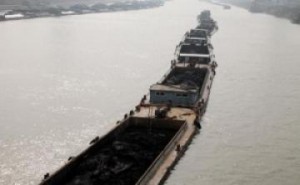 A new draft regulation provides for a ban on the import of low-quality coal and for higher standards of thermal coal produced in China. It is part of a wide-ranging programme of policies to constrain the rise of energy consumption and to reduce pollution. Whether this regulation is formally issued will depend on the influence of the coal and power companies on policy-makers and on the government’s determination to press ahead with its clean energy agenda. If implemented successfully, it would support other measures being developed to reduce pollution from coal combustion and to diminish China’s dependence on coal. Coal continues to be the main source of energy in China, accounting for about 68% of primary energy supply in 2012. Although this is significantly lower than the 75% share seen in the mid-1990s, the government has long struggled to reduce the proportion of coal in the energy mix to below 65%. China’s production and consumption of coal have both doubled since 2003, and the country now accounts for half of the world’s coal use. Imports of coal have also risen, and about 20% of seaborne internationally-traded coal went to China in 2012, though this amounts to just 4% of its annual demand.
A new draft regulation provides for a ban on the import of low-quality coal and for higher standards of thermal coal produced in China. It is part of a wide-ranging programme of policies to constrain the rise of energy consumption and to reduce pollution. Whether this regulation is formally issued will depend on the influence of the coal and power companies on policy-makers and on the government’s determination to press ahead with its clean energy agenda. If implemented successfully, it would support other measures being developed to reduce pollution from coal combustion and to diminish China’s dependence on coal. Coal continues to be the main source of energy in China, accounting for about 68% of primary energy supply in 2012. Although this is significantly lower than the 75% share seen in the mid-1990s, the government has long struggled to reduce the proportion of coal in the energy mix to below 65%. China’s production and consumption of coal have both doubled since 2003, and the country now accounts for half of the world’s coal use. Imports of coal have also risen, and about 20% of seaborne internationally-traded coal went to China in 2012, though this amounts to just 4% of its annual demand.
The plentiful supplies of cheap coal may have been a blessing in that they have underpinned China’s economic growth over the last 30 years, but they have also been a curse. Not only has the exploitation and use coal caused serious pollution to land, water and air, but its’ very cheapness has supported wasteful practices along the full length of the supply chain. In 2004 the government announced a plan to reduce energy intensity by 20% between 2005 and 2010. This objective was almost achieved, largely by focusing on improving the energy performance of the most energy-intensive industries through applying mainly administrative measures. The twelfth five-year plan (2010-2015) sets three specific targets: to reduce energy intensity by 16% over the period 2010-2015, to increase the share of non-fossil fuels in energy supply from 8.6% to 11.4%, and to reduce carbon intensity by 40-45% between 2005 and 2020. Though laudable in themselves, these targets do not set caps on absolute energy consumption or on total carbon emissions.
Over the last three years the government has been touting a range of measures to constrain rising energy demand, to reduce pollution, and to reduce the share of coal in the energy mix. Early in 2012, the government appeared to set a ceiling for total energy consumption of 4.1 billion tonnes of coal equivalent for the year 2015. This was then reduced to 4.0 billion tonnes in January 2013. Given that total commercial primary consumption in 2012 was about 3.62 billion tonnes of coal equivalent, this cap would require the annual rise in energy demand to remain below 3.5% over the period 2013-2015, less than the 3.9% seen in 2012. In support of these objectives, the government has set caps on the national production and consumption of energy, has proposed a cap on greenhouse gas emissions for 2016, is considering introducing a range of taxes on energy production and use, and has set up experimental carbon trading markets.
In late May, China’s National Energy Administration published a proposal for a temporary ban on the import of low-quality coal purchased by power stations. The draft regulation sets a minimum calorific value of 4,540 kilocalories per kilogramme (on a net, as-received basis) and maximum contents of sulphur and ash of 1% and 25% respectively. Such low quality coal, known as brown coal or lignite, accounted for about 25% of the country’s coal imports in 2012, and comes mainly from Indonesia. The same draft regulations also set standards for domestically-produced brown and black thermal coal, though the standards for domestic brown coal are lower than those for imported coal. The official reasons given for the ban are to better regulate the production and distribution of coal in China and to improve the quality of coal used by power plans and industry.
Last year was certainly a chaotic time for China’s coal industry. Excessive production led to the accumulation of huge stockpiles at the same time as imports were reaching record levels. The proposed import ban, combined with the new standards for domestically-produced thermal coal, would provide some protection for domestic coal mines, both the new, large mines which produce higher quality coal and some of the older mines which have very high costs. Two parties are less pleased with the proposed ban. Within China, the electrical power generators foresee a rise in coal prices which will further squeeze their profits, for these companies continue to be trapped between a coal market which is driven by supply and demand and a wholesale price which is set by the government. Outside China, small-scale miners in Indonesia will suffer the most from the ban, as they will be unable to blend their brown coal with high quality material to reach the required standards. If the total level of Chinese coal imports are maintained, the winners will include the larger-scale mines in Indonesia as well as those in Australia and South Africa.
As at the date of writing, the proposed ban has yet to be formally issued. If it does come into force, two key uncertainties remain. Firstly, to what extent will the authorities be able to implement the ban on low-quality imports, for the smuggling of energy products along China’s coast is a long-standing practice to by-pass restrictions on imports or exports? Secondly, even if the import ban is successful, will the effect just be to protect domestic mines or will government succeed in constraining the total production and consumption of coal and in raising its quality? In the past, the unreliability of coal data and the questionable effectiveness of purely administrative policy instruments have together undermined similar short-term policy initiatives. If the government is to succeed in its objective curbing coal and energy consumption as well as pollution, it will need to deploy a range of administrative and economic instruments.



